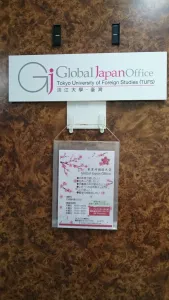2017 Activity Report
March Activity Report
3 April 2018
Global Japan Office Coordinator
Ai Sagawa
March is here, and days where Tamsui instantly feels the rays of early summer are increasing. Everyone is starting to wear short sleeves and shorts. A few classes even turn on the air conditioning. It feels like the short winter is over, and spring was skipped in favor of a long summer.
Around mid-March, the examination to select exchange candidates from Tamkang University’s Japanese department was held. Students in the Tamkang University Japanese department have two ways they can go to Japan on exchange. One way is through the Japanese department exam. The other way is by taking the exam held by the Tamkang University International Exchange/International Education division. The universities on offer and starting periods of the exchange depend on which path you go through. Students can also apply to more than one university. Because of this, many students aiming to go on exchange came to the GJO Taiwan Office to practice for the interview and get their Japanese application documents checked. After the selection, there were some students who couldn’t go to the schools they wanted, but they got to choose different universities, and obtained their tickets to a Japan exchange experience. Most students going on exchange to Japan have been before either on vacations or short-term winter/summer programs, but this time they will be there for a whole year, so I hope they will use this opportunity to improve their Japanese skills, broaden their horizons, and challenge themselves to do many things.
In other news, I will finish my studies in March, and from April I will start a new job in Taipei, so from next month onwards someone else will take over my responsibilities here at the Taiwan GJO. On my last day in the GJO, students that visit the office a lot came to see me. The new coordinator is acquainted with many of these students, so I hope the Taiwan GJO continues to succeed.
February Activity Report
2 March 2018
Global Japan Office Coordinator
Ai Sagawa
In Tamsui, where Tamkang University is located, it has been constantly cold from late-January until mid-February. Taiwanese houses don’t usually have heaters, and many houses have tiles for flooring, so it feels even colder than it is. However, the temperature started rising at the end of February, and it finally felt like spring. When the sun came out it felt like early summer temperatures, and I saw many students around campus wearing shorts and t-shirts. Around the campus and my house there are many cherry blossoms/plum blossoms in full bloom.
In Taiwan, the 2018 Lunar New Year’s Eve was on February 15th. The second semester at Tamkang University started from February 26th. The campus, which was deserted after the end of the examination period in mid-January, is filled with students again, and has me wondering where the tranquility of New Year’s has gone.
At the Taiwan GJO, before the new semester started, I sent a survey out to students who visit the GJO a lot to see what the best times to open the office would be. As a result, students came to the office immediately once the new semester started. Since they came during their break time, it was only a short visit, but they told me all about their spring breaks. I felt that perhaps one role of the GJO is giving students a place to speak Japanese, even if it’s only briefly.
Since ‘Hinamatsuri’ is in March, I want to put up decorations with my students. Also, since there are students going on exchange from April (matching up with the Japanese academic year), I want to meet with them and address any questions or worries they might have.
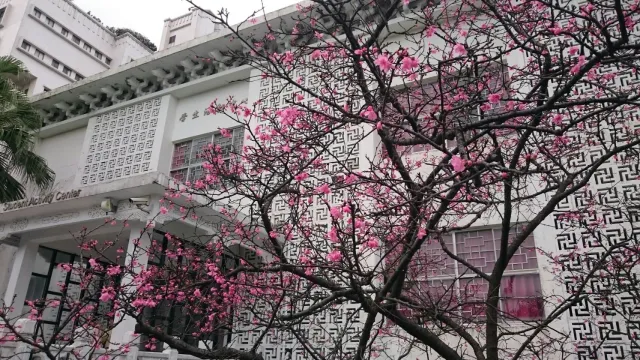
January Activity Report
5 February 2018
Global Japan Office Coordinator
Ai Sagawa
Tamsui is in the northern part of Taiwan, so it is a place where the summers and the winters are humid. Since Taiwan is south of Japan, its winters have an image of being warm. However, the temperature does go below 10 degrees in winter. In particular, due to a cold wave in late January, snow was seen on a mountain in Taiwan that measures over 2000m tall, and the surprised faces of local citizens was broadcast on television for days.
In Taiwan, New Years is celebrated according to the old lunar calendar, so the 1st of January is a holiday, but if the 2nd falls on a weekday, schools and workplaces start up again for the year. At Tamkang University, classes started again on the 2nd of January. Final examinations from the previous semester were held during ‘test week’ from the 15th until the 20th. After this period, most students go back to their hometowns for Chinese New Year. Because of this, the university is deserted come late January.
At the GJO Taiwan Office, I’ve been talking with students who come to the office about differences in Japanese and Taiwanese culture, and have also been answering study-related questions before the final test period. In terms of cultural differences, we talked a lot about differences in our middle school and high school history textbooks. In Taiwan, students study Taiwanese history, Chinese history, and world history, with Taiwanese history starting from the Paleolithic Era. I would love to look at an actual textbook if I get the chance. Another difference talked about was differences in wedding ceremony styles. For example, the concept of a ceremony and a reception, and seating arrangements at the reception. In Taiwan, the parents and relatives of the bride and groom sit nearby at a large round table. Coincidentally, I actually attended the wedding reception of one of my Taiwanese friends in late January, and got to experience the Taiwanese wedding style myself.
In regards to questions about exams, students asked me about words they didn’t understand relating to ‘basic income’, a concept covered by the Japanese news media, and so I helped them out while also checking they knew the consequences surrounding the topic. In addition to this, together with other students in the room, we discussed the merits and demerits of introducing ‘basic income’ in Taiwan. As we talked, the demerits were emphasized more than the merits, and we came to the conclusion that more in-depth analysis of the economic situation in Taiwan is needed to differentiate between what is a merit and what is a demerit.
In other news, some students who were to give an address to a group of 70 Japanese high school students visiting Tamkang University on a study tour came to the office, and asked for help with the content of their speeches, so I checked their grammar and helped them practice reading their speeches. On the day of the address, I also happened to be in attendance, so I was glad that I could see them reciting the memorized speeches they worked hard on in front of many people. I also made Fai Chun with some students who visited the office. Fai Chun are the decorations hung in the doorway of shops and houses during the New Year, and are made by writing words of celebration on red paper. Fai Chun range from those featuring one kanji, to those featuring five or even seven. The students who participated haven’t used a calligraphy brush for a long time, so it was difficult for them, but they seemed to enjoy themselves.
The next semester begins on February 26. I want to start activities for this semester by asking students about their Chinese New Year memories, and inviting Japanese exchange students to chat with them.
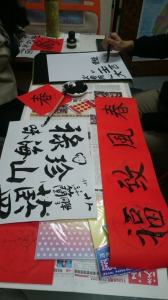
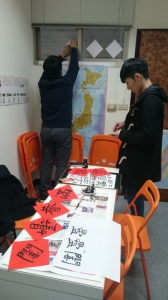
December Activity Report
3 January 2018
Global Japan Office Coordinator
Ai Sagawa
December in Tamkang is sometimes chilly, with the daytime temperature falling to around 15 degrees Celsius, but it is also sometimes warm and springlike with days where the temperature reaches over 20 degrees. In the end of December we had days with mild temperatures and it was indeed good weather for end-of-the-year cleaning. However since in Taiwan the New Years is celebrated according to the old lunar calendar, anticipation for the solar New Year is not as strong as it is in Japan. In 2017 we have class until the 29th of December, and class starts again from the 2nd of January the following year.
As a part of TUFS’ Joint Education Program, we engaged in an activity in which students at TUFS, at Fuzhou University in China, and at Tamkang University in Taiwan debated together over Skype. This debate was hosted by a native Japanese student in Japan, and was participated in by Japanese learners over the internet.
In the Japanese education course, the students were provided with the opportunity to take a look at an environment in which Japanese is used, and it is possible that the debate speeches, once written down, could be used an educational resource. On that day, I took part in international exchange at a high school in Taoyuan which has a Japanese department. In my place, I had classmates participate on my behalf. From Tamkang University we had Mr. Hu and Mr. Chien participated in the debate. I was a bit worried about whether they could coordinate together, having only met them that day, but they prepared in advance and I hear they engaged in worthwhile debates. I also heard later that they had fun speaking Japanese.
Among students that visit the GJO, some have Japanese friends in Japan. As it is December, I received a number of questions regarding New Year’s greeting cards. The questions were about how one should ask someone for their mailing address, and about what kind of messages to write on New Year’s cards. What left a strong impression on me was one student who asked their friend for their address to send the New Year’s card to, only for the friend to say that they did not want any New Year’s cards because there had been a death in the family. The student asked me how they should respond to this. I think the students were able to learn a little more about Japanese culture through writing New Year’s cards.
With the students planning to study abroad in Japan in 2018, we talked about the methods of transportation to take from the Japanese airport they would be arriving in to their dormitories, and what kind of rooms they would want (how many beds and what kinds of amenities).
Around the middle of December we decided to put up a Christmas tree on the door of the GJO because Christmas time was nearing. We discussed the design with the students who were there that day, and went to the co-op inside the campus to buy the materials. We made decorations out of origami. And in the end of December we had students briefly introduce their favorite things using PowerPoint. We had Japanese students participate as listeners and had them also ask questions.
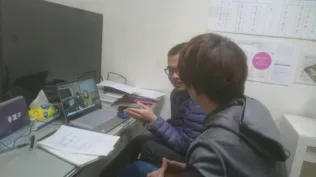
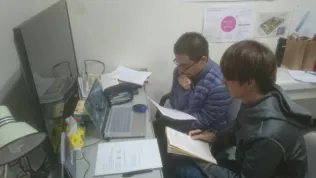
Picture 1: A look into the long distance debates with TUFS, Fuzhou University, and Tamkang University.
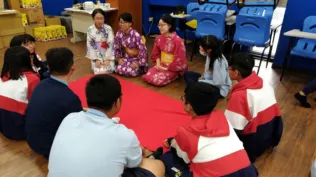
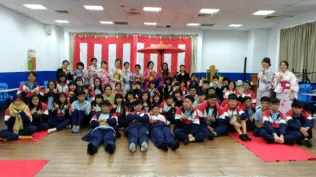
Picture 2: A look at the Japanese cultural exchange in Taoyuan on December 1st
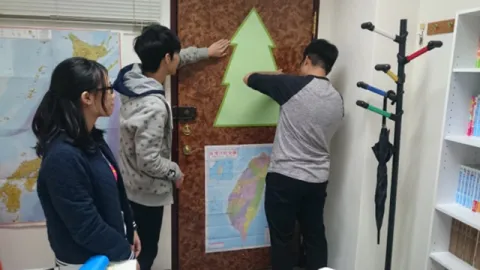
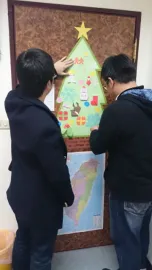
Picture 3: Putting up the Christmas Tree
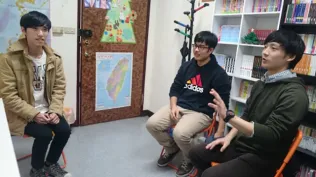
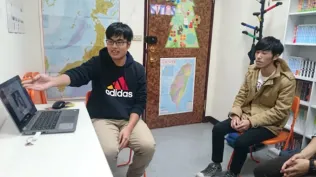
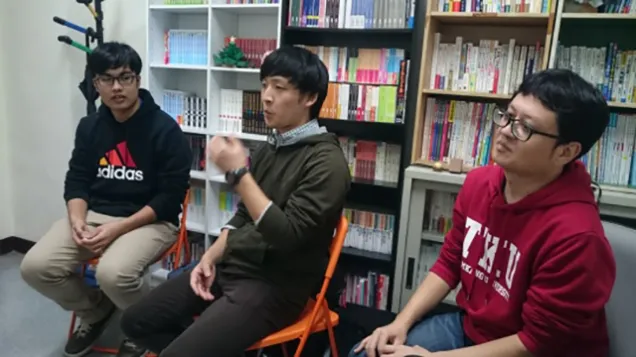
Picture 4: Talking about their favorite things
November Activity Report
1 December 2017
Global Japan Office Coordinator
Ai Sagawa
Taiwan in November fluctuates between hot days and chilly days, with the temperature varying wildly from day to day. In Tamkang on hot days we can hear the chirping of some kind of bug, possibly cicadas, and walk around in half-sleeved shirts; on cold days we have to wear coats and scarves. The temperature will gradually drop from now. Winter in Tamkang consists of days of drizzling rain, and the moist cold takes a toll on us. Mid-term exams for the first semester were held over a period of one week starting on the 20th of November.
At the GJO Taiwan office, as in the previous month, the office is open for two hours every day from Monday to Friday. In the beginning of November we continued the online chatting activity that we had been doing since the end of October. After the activity was over, Taiwanese students who had studied abroad before and Taiwanese students who had never studied abroad before exchanged information on studying abroad in Japan.
During the open hours of the GJO we always talk with the students; the topic of interest that left an impression on me this month was about how to infer the intentions of a Japanese person with whom one is texting. There are students that spent some time in Japan by participating in summer programs and such. They are still in touch with the Japanese people they came to know during that time. In some cases, as the end of the year was approaching and the Taiwanese students, hoping to send New Year’s Cards to their Japanese friends, would ask their Japanese friends for their mailing addresses, only to find their Japanese friends declining. This led us during discussion to address the topic of what people really mean when they say things and how we should respond.
We also played the Yamanote Line game, but following a student’s suggestion we changed the stations with names of Japanese prefectures. There is a map of Japan in the room, so each one of us said out loud the names of Japanese prefectures. We paid attention to each other’s pronunciation and the geographical locations, and although it took time we enjoyed the game. Next time we are planning on playing the game with the names of prefectural capitals.
With mid-term exams approaching in November, I had a number of students come to me with questions regarding Japanese that they didn’t understand. Also we practiced listening comprehension using “Academic Japanese Listening for International Students” edited by the JLC at TUFS. When dealing with two students who were in the same academic year, but whose proficiency levels in Japanese were different, I would ask them questions about the content in order to supplement their comprehension.
In the beginning of November, a freshman in the Japanese Department came to visit the GJO, because they had to interview a Japanese person as part of their class. For me it was a good opportunity to have them learn more about the GJO. At the end of the month we received a visit from Japanese exchange students studying at Tamkang University, and they talked together with Taiwanese students about where they were from and what specialties there are in their home towns. I think this was a good opportunity for students to listen about the various kinds of pronunciation used by Japanese people.
Also, a student studying Japanese in night school also dropped by. Until now I had been only targeting day time students, but I came to feel that I should also advertise the GJO to night school students as well. If it was convenient for them (the night school classes start from 18:00), they might come over before classes.
The photo below shows how the online chatting activity went in the beginning of November. Some of the participants of the online chatting activity in the end of October are also here.
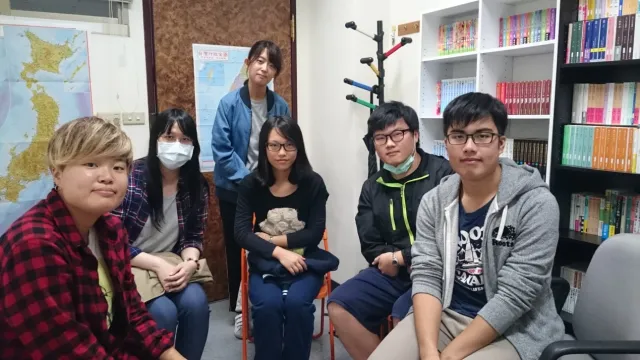
October Activity Report
1 November 2017
Global Japan Office Coordinator
Ai Sagawa
October in Tamsui is a time of constantly changing weather, in which hot days are often followed by sudden temperature drops. When I look at Japanese news, there are stories about the autumn leaves and the first snow, but Taiwan is still the temperature of a late summer/early autumn. Tamkang University was very lively during the beginning of the new semester mid-September, but the campus seems to have settled down during October. Around this time of year every year, a memorial ceremony is held to commemorate the founding of Tamkang University. This year is the 67th anniversary.
At the GJO Taiwan branch, we are visited by more or less the same students as last semester. This semester, the office is open for two hours every day Monday through Friday. Students visit us almost every day to talk about what they’ve been doing and thinking lately, and to ask Japanese language-related questions. There was a period of consecutive holidays in October thanks to the ‘Mid-Autumn Festival’ and the ‘National Day of the Republic of China,’ so many of the students told me about their plans for the holiday, and, upon return, told me about where they went and what they ate. During Taiwan’s Mid-Autumn Festival, it is a custom to eat mooncakes and have barbeques. Both before and after this festival, the smell of barbeque lingers in the air.
Some students are planning to go on exchange to Japan next year, and so are coming to the office to have the Japanese on their documents checked. Also, we have the popular vacation magazine ‘Co-Trip’ available in the office, so these students often come to read about ‘little trips’ they can go on at their study abroad destination. Most students who come to the GJO come to talk with me, but it seems that there are times where they just want to read some of our books, so I want to ask the students what they want to do, and let them enjoy their time in the GJO.
When students visit the GJO, I usually talk to them one-on-one, or one-on-two, but sometimes four or five students come at once. When many students come at once, there is a tendency for them to to use more and more Chinese when speaking. However, when talking about the same topic together, the students can discuss Japanese vocabulary they aren’t sure of in their native tongue (Chinese), and support students who can’t quite keep up with the conversation, so I think we have made a good environment for the students.
At the end of October, I got some Taiwanese students and Japanese students together for a ‘chat exchange.’ We wrote the topics of this time’s chat on small pieces of paper, and had the students draw them out to start a sort of ‘lottery chat.’
As for advertising the GJO, I have been asking GJO regulars to hand out A4-size posters at their classes and club activities. I don’t think any students have come since seeing these, but at least they know about the existence of the GJO room. Also, I asked for permission in advance and spoke to a few teachers’ classes about the GJO.
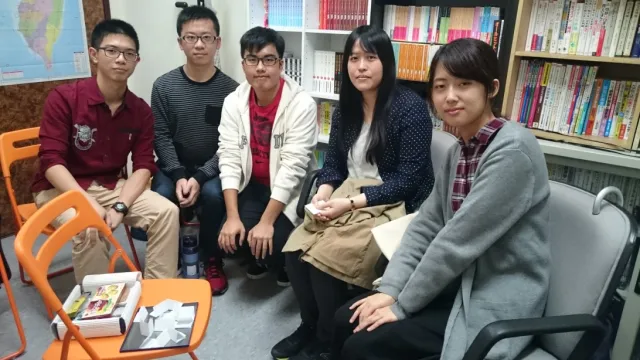
September Activity Report
30 September 2017
Global Japan Office Coordinator
Ai Sagawa
The hot summer days continue in Tamsui, having a cooler is a crucial at this time. Despite this, I think the sunlight during the day is a little weaker in comparison to July and August. The wind has become cool enough to feel the difference. I realized that the last few days have been shorter than those in the middle of summer, so I can really feel the changing of the seasons. The cicadas have also stopped chirping.
The new academic year begun on the 18th October here at Tamkang University. The campus is filled with students again, the same as before the summer vacation. When I see the new students that wander from classroom to classroom, and older students promoting club activities, I really feel the presence of the new academic year. In Japan, the new academic year always starts in April, so from my perspective this is the time of year before the weather becomes warmer, but in Taiwan it is about to become colder. I’m still not used to this, but I understand from experience that this is what an autumn start feels like.
Here at the GJO Taiwan Office, we prepared the room for the new semester by assembling new bookcases, and rearranging the office furniture. As the new semester began, students who often visited the office last semester started coming to the office again. They shared stories of their summer vacations with me. One male student used his vacation to participate in a military camp, and shared his experiences of it with me. He stood out as being very tan, which was probably due to the outdoor practices at military camp. The students that visit the office regularly took the Japanese Language Proficiency Test in July, and told me of their respective levels and results. There was one student who said they have decided to challenge a higher level in the upcoming December examination. Aside from the regular visitors, new students also came and visited the office. Some had been invited by regular visitors, and some came to get the Japanese in their exchange applications for next year proofread.
Since the new semester has begun, I intend to promote the GJO to new students, and also to current students that do not know about us. On top of informing all students of the Japanese department, I also tend to inform students belonging to clubs and circles related to Japanese culture. Here at Tamkang University, there is a karuta club, a tea ceremony club, an awa odori club, an anime dubbing club, and a Japanese archery club. In these clubs, there are some students who are not part of the Japanese department, but are interested in Japanese language and culture. I hope there is a chance to promote GJO to these students.
August Activity Report
31 August 2017
Global Japan Office Coordinator
Ai Sagawa
Tamsui is hot every day, as usual, but compared with the start of the month, I think the end of the month is a little cooler. There was a big event in Taipei this August. This was the ‘2017 Summer Universiade.’ Running for 30 days from the 19th of August, various matches were held all over Taipei. Tamkang University was the site of the weightlifting competition. From the early morning I saw many people lining up to buy tickets beside the gymnasium, where the event was held. Last night a closing ceremony was held in Taipei. I watched the ceremony via relay broadcast on the television. The events that were particularly reported, because of Taiwanese athletes, were: rollerskating, badminton, weightlifting, men’s 100m, men’s tennis singles, taekwondo, and gymnastics.
During the Universiade, Taiwanese sports channels focused, understandably, on the events with Taiwanese athletes, so I didn’t know how the Japanese athletes were faring, but last night when I looked at the medal board, Japan had a total of 101 medals (37 gold, 27 silver, 37 bronze), which I then learnt made us the country with the most medals in the Universiade. Taiwan is the country with the third largest amount of medals (total 90: 26 gold, 34 silver, 30 bronze). The next Universiade will be held in two years in Napoli. I am very glad that I just happened to be in Taiwan as a GJO Coordinator while this big event was on, and had the chance to see it firsthand.
Tamkang University starts the new semester on the 18th of September, so it is still summer vacation right now. In the GJO Office, we are changing the room around a little bit, and putting new bookcases together for the new semester. Until now we only had a world map and a map of Japan, but we decided to also display a map of Taiwan. We thought it’d be visually easier when we ask Taiwanese students about their hometowns and vacation spot recommendations. Two students helped me assemble the bookcases, and I was able to display all the books that had been sitting in boxes until then. In the new semester I want to promote the GJO and the books. Also, I am thinking of arranging the books by genre so students that come to the GJO can pick out books based on their interests. In other news, I am also going to put up posters (in Japanese and English) advertising the TUFS Winter School. I already put the Japanese poster up outside the Japanese department office. I am planning to put the English version up in the ‘chat corner’ where Taiwanese students and exchange students often meet. Since there are also students from other departments at Tamkang University who study Japanese, I will try to put posters up in places where as many students as possible can see them.
Assembling the Bookcases↓
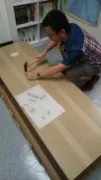
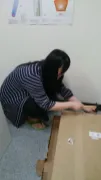
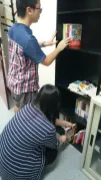
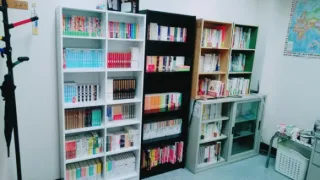
The Universiade Opening Ceremony↓
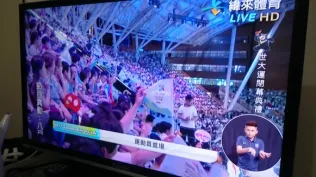
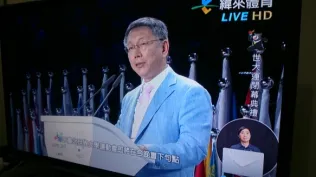
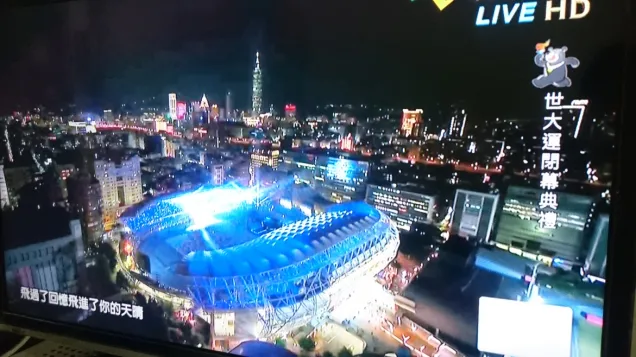
Last month at the 2017 Summer Universiade, Tamkang University was the site for the weightlifting competition. Flags and banners were put up a few days before the Universiade begun. The flags bore an illustration of the event’s mascot, the Taiwanese Formosan black bear, lifting weights. Names of the sponsor companies were displayed on the white part at the bottom of each flag.
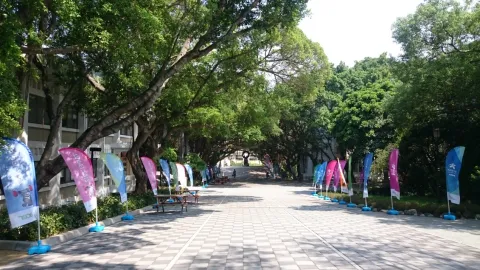
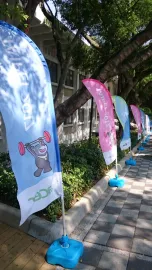
July Activity Report
1 August 2017
Global Japan Office Coordinator
Ai Sagawa
July in Tamsui has less rainy days compared to June, and continuous days of fine weather are becoming more common. However, when the weather becomes like this, you can tell that a typhoon is coming. A few days ago, Typhoon 9 and 10 directly hit the main island of Taiwan. The middle, eastern and southern regions were particularly affected, and was broadcast on the news every day. For someone like me, born in Nanbu, Kyoto, I don’t have many memories of typhoons being particularly destructive, but at this time of year Taiwan is always hit by multiple typhoons, so I feel like I should be more prepared and cautious than when I am in Japan.
Tamkang University’s summer vacation began last month, in the middle of June, so campus was very quiet in June and July. However, it seems that during this period there is a Chinese Summer Camp for students who are not native Chinese speakers, and so they can be seen on campus doing activities with local Taiwanese students. I too participated in this summer camp, which is run every summer break by students of the Tamkang University Education Department, and taught origami, as an introduction to Japanese culture, to middle school students at a relatively small school in the suburbs. The students had never studied Japanese before, but I thought it was a good opportunity for them to hear natural Japanese, so I mixed both Japanese and Chinese while talking with them. I got the Taiwanese student paired with me to explain the parts I could not.
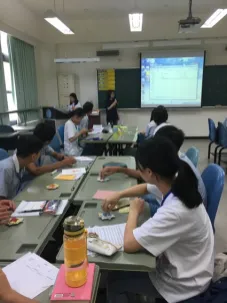
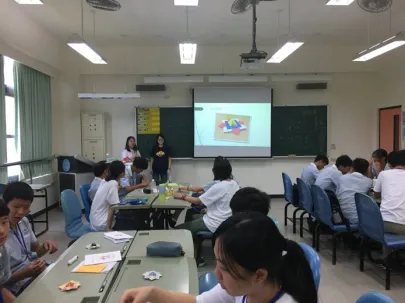
【Thoughts on Summer Camp】Up until now, this camp had been run every year by Taiwanese students and teachers, but this year they decided to let foreign exchange students participate (as volunteers) too. On the day of the camp, Sagawa taught origami (specifically 3-paper spinning tops) to students as an introduction to Japanese culture. The students in this picture are third year middle-schoolers.
Not many students visit the GJO Office during the summer vacation, but one student did come at the end of the month. This student had left Taipei and gone home for the summer, but returned for 3-4 days to attend an event. We usually tell students exactly when we are open during the vacation, and this student was so kind as to look at these times and come accordingly. After meeting and speaking in Japanese with me, the student lamented that since the start of the vacation they did not have many chances to use Japanese, and so felt that their speaking ability had gotten worse, but it seems they have been studying on their own, and after showing me the textbook they had brought, the student said they would work hard to be able to naturally converse in Japanese. From my own experiences, learners of Japanese always seem to use the sentence structures they’ve learnt in class when they speak, so it is a little different than the Japanese that native people speak. I felt the difficulty involved in switching to speaking Japanese that meets the student’s needs.
In August I think I will ask for cooperation from the Japanese Department Office to help with advertising for the GJO Office. Also, I haven’t organised all the books the GJO Office has received, so I’d like to get a bookcase to do this, and change the room up a little.
June Activity Report
30 June 2017
Global Japan Office Coordinator
Ai Sagawa
Here in Tamsui, the rain didn’t let up until mid-June, but now it has finally become Summer. Cicada chirp cheerfully from the early morning, and the morning heat wakes me up every day. Tamkang University had their graduation ceremony on the 10th of June, and the end of year tests were held in mid-June. After the test period, summer vacation began, and now the campus is deserted.
As aforementioned, we were aware of the looming test period, and decided to have a chat session at the very beginning of June. This time’s theme was ‘popular fads from your childhood,’ and we discussed the differences between Taiwan and Japan. Eight students were able to attend; two Japanese students, and six Taiwanese students. In terms of the theme, the conversation mostly revolved around the cartoons the students used to watch. Japanese cartoons, or anime, are regularly broadcast on Taiwanese television, so whenever a Japanese student mentioned a different anime, the Taiwanese students would say ‘I know that one,’ or ‘I’ve seen that one.’ In addition to that, anime that are no longer being broadcast in Japan are regularly rerun in Taiwan, so the Japanese students were surprised by the titles that the Taiwanese students brought up. The Japanese students also discussed the generation gap they felt now from the anime they watched as children, which surprised the Taiwanese students. After this discussion, there was some time remaining, so the Japanese students shared the things that surprised them about Taiwan with the Taiwanese students. The Taiwanese students were able to hear what ordinary things seemed strange to the Japanese students, and I think it was a good opportunity for the students to think about their daily lifestyles objectively.
Apart from chat sessions, we also celebrated a slightly early Tanabata. We made a tree out of paper to hang on the back of the GJO office door, and called upon Taiwanese students studying Japanese, and Japanese exchange students to write and hang their wishes on the tree. The Taiwanese students also researched how to do origami and I watched them make many paper decorations while helping them in Japanese.
In July, summer vacation begins, so while there will not be many students on campus, there are summer courses being taught, and I intend to promote GJO through these. Also, some postgraduate school classmates have reached out to me that they want to meet some students that want to practice Japanese, so I hope to see them at our next session. As well at promoting GJO, I feel that it is also necessary to aim these promotions at students with many friends and acquaintances who are studying Japanese.
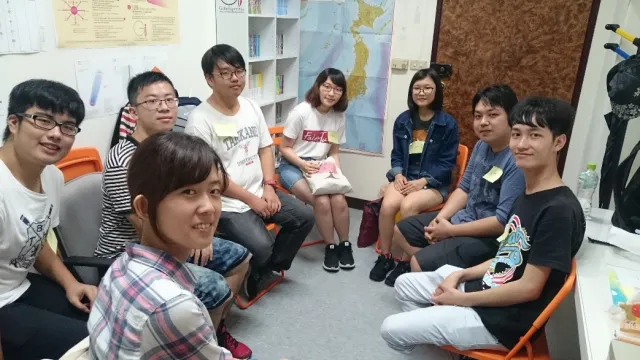
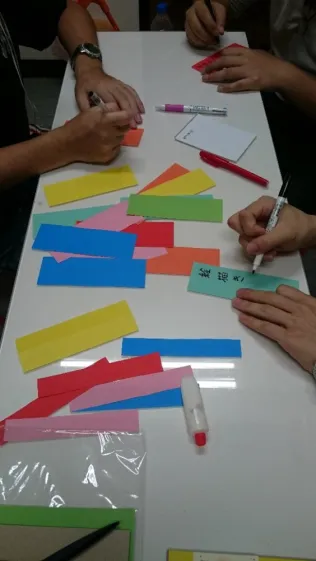
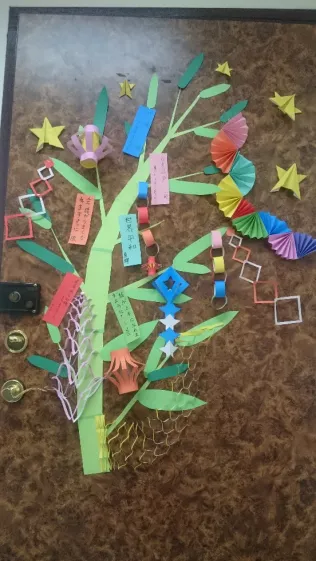
May Activity Report
31 May 2017
Global Japan Office Coordinator
Ai Sagawa
Recently, we have been feeling the summer sun more and more here in Tamsui. At Tamkang University, the the fourth year students’ graduation exams take place in the end of May, and the graduation ceremony will be held on 10th June. In addition, in the middle of June is the end of term test week. A distinct end-of-term atmosphere has settled in throughout the campus.
At the GJO office, we get students coming to visit almost every day that the office is open for things like idle chat and games. We played a game of ‘bouzu mekuri’ with Hyakunin Isshu (a classical anthology of Japanese poems) cards. After checking the rules in Japanese, we began the game, but we stopped many times halfway through to appreciate the poems written on the cards and to check the readings of the Japanese. In order to check the meanings of the poems, we referred to the ‘Chihayafuru Waka Guidebook’ that was sent to us from TUFS to find out the authors, the meanings of the poems, and the context in which they were composed. The students read the poems on the cards, and while at first were confused and made mistakes with the pronunciation, after reading various different poems and getting used to the rules for the readings, they became absorbed in the cards and tried reading them aloud. One student said that, although they knew about Hyakunin Isshu cards, they had never actually looked at them carefully before. I hope that the students and I can go on to get a feel of classical Japan together.
As one of the activities at the GJO, in the middle on the month we held a chat session with some Japanese international students and Taiwanese students. Including myself, 4 Japanese students and 5 Taiwanese students came along. We set Taiwanese and Japanese culture as our topic, and we talked about ‘The Differences between Student Life in Taiwan and Japan’, including student life in primary, middle and high schools. I think that, for the Taiwanese students, this was an opportunity to use the Japanese they have learnt to freely talk about their own experiences, and for the Japanese students it was a chance to learn about one aspect of Taiwanese culture. Also, the Japanese students talked about their own student lives, so for the Taiwanese students it was also a chance to listen to native Japanese speakers. One thing that came under much discussion was the way of having lunch. The students talked about things like whether they eat school lunches or packed lunches, how the school lunches are made and brought to the classroom, and what they put in their packed lunches. The thing that surprised the Japanese students was that in Taiwan, there is a machine for heating up lunchboxes called a ‘Zhēng fàn xiāng (蒸飯箱). As the characters suggest, it is a machine that uses steam to heat lunchboxes, and according to the Taiwanese students, the students who bring packed lunches put them into the machine around the 3rd or 4th periods, and by lunchtime they are ready to be taken out and eaten. The Taiwanese students say that cold lunchboxes don’t taste good. In the session, the students introduced themselves to each other and made simple name tags. I hope that getting to know each other’s the names and faces will encourage more exchange between the Japanese and Taiwanese students. I am planning another chat session in June, and I am looking forward to seeing what kind of conversations we have.
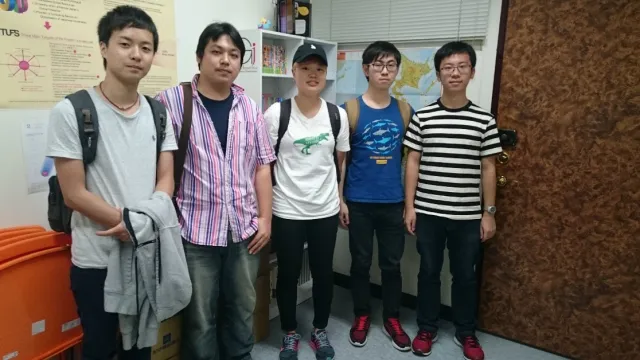
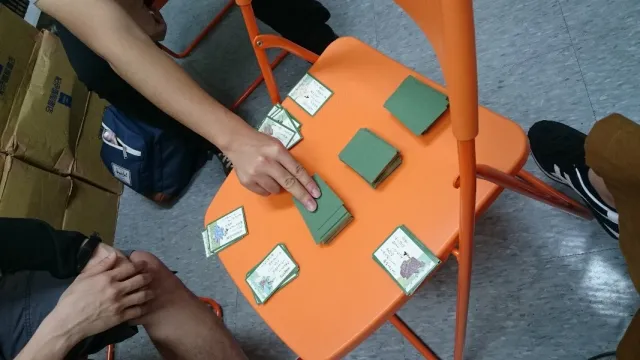
April Activity Report
30 April 2017
Global Japan Office Coordinator
Ai Sagawa
As of April, the GJO Taiwan Office Coordinator has changed. My name is Sagawa Ai and I am a second year master’s student at Tamkang University. I intend to do my very best to carry on the work of the previous coordinator and spread the word about the activities of the GJO. I am looking forward to the days ahead.
After entering April, Taiwan had an extreme change of weather, with an erratic mixture of hot, summery days and rainy, chilly autumnal days. In this season it’s easy to catch a cold, so I am being even more careful of my health than usual.
In early April in Taiwan, on the 3rd there is Children’s Day, and on the 4th is the Qingming Festival (a day a bit like the Bon Festival in Japan when people visit graves). Tamkang University, where the GJO Taiwan office is located, there is a roughly 1 week-long holiday between these two festivals. It feels as though Japan’s Golden Week has come a month early. Also, at the end of the holiday in mid-April is the second term mid-term exam week. During the holiday, many students return to their parents’ homes, and in exam week they are hard at work studying for tests. Because of that, I didn’t hold any big activities in April.
I didn’t hold any big activities, but in April the GJO became the Chat Corner and received visits from students. I officially took charge from April, but in March I was introduced to the students who often come to the office by the previous person in charge, so in April I was mainly having fun using Japanese with them, doing things like exchanging information on Taiwanese and Japanese culture and having them explain the rules of board games (Othello, chess, shogi) in Japanese before having a go at playing them.
When the office opened in April, in order to continue spreading the knowledge of the GJO, I made an informative poster about the GJO and put it up on the noticeboard in the corridor in front of the Japanese Department’s office. With the aims of making students to feel free to come by the office and to create a GJO ‘Chat Corner’, I put in marketing phrases like ‘I want to speak in Japanese!’, ‘I want to talk to Japanese people!’, and ‘I want to have the Japanese grammar in my report checked!’. Upon doing so, there were students who came to visit the GJO. From now on I think I will make posters regularly. Also, I intend to distribute small posters so that lots more students will see them. The plan is to continue turning the GJO into a Chat Corner from here on. I want to create a space where students can feel free to drop by to talk with Japanese people and discuss studying abroad.
At the end of March, a doctorate student from TUFS came to Taiwan for their research. They will be using the GJO Taiwan Office to conduct interview surveys until early May. They asked me to gather participants in advance, so I asked the Japanese Department and had them send a mass mail calling for participants to undergraduate and postgraduate students of Japanese. Also, I asked people individually to contribute in the survey. Thanks to them, we managed to gain a little over the target number of applicants.
The plan is to have exchanges with the Japanese student in May. The topic has been decided, so from here I want to decide the times and dates publicise them, and have as many students as possible take part. Now, I’m happy to say that the investigation is progressing smoothly. The topic has been decided, so from here I want to decide the times and dates publicise them, and have as many students as possible take part.
*The photo below shows the poster (A4 size) on the door of the GJO. I have put a B4-sized copy up on the noticeboard in the corridor of the Japanese Department.
